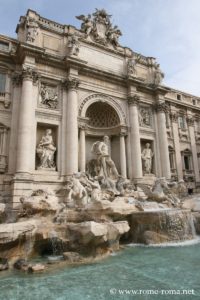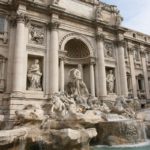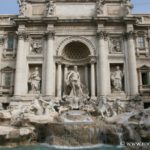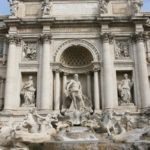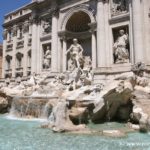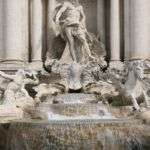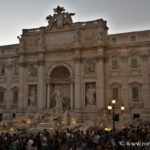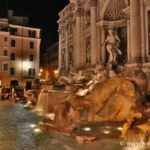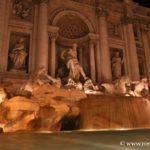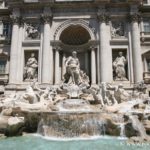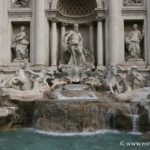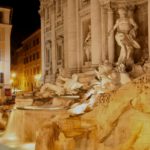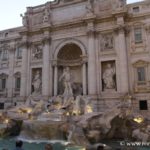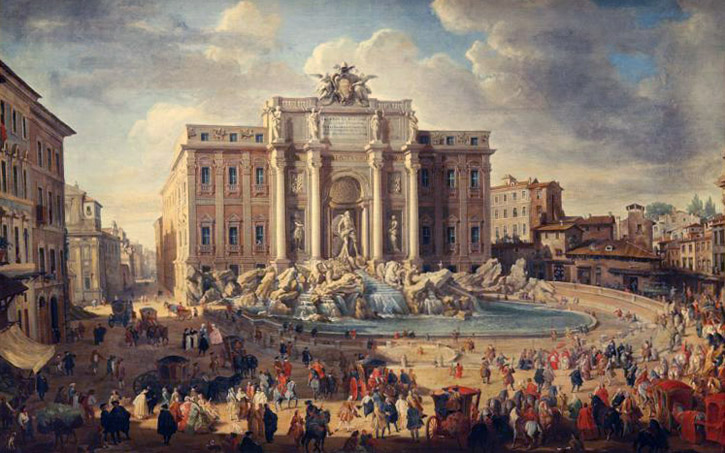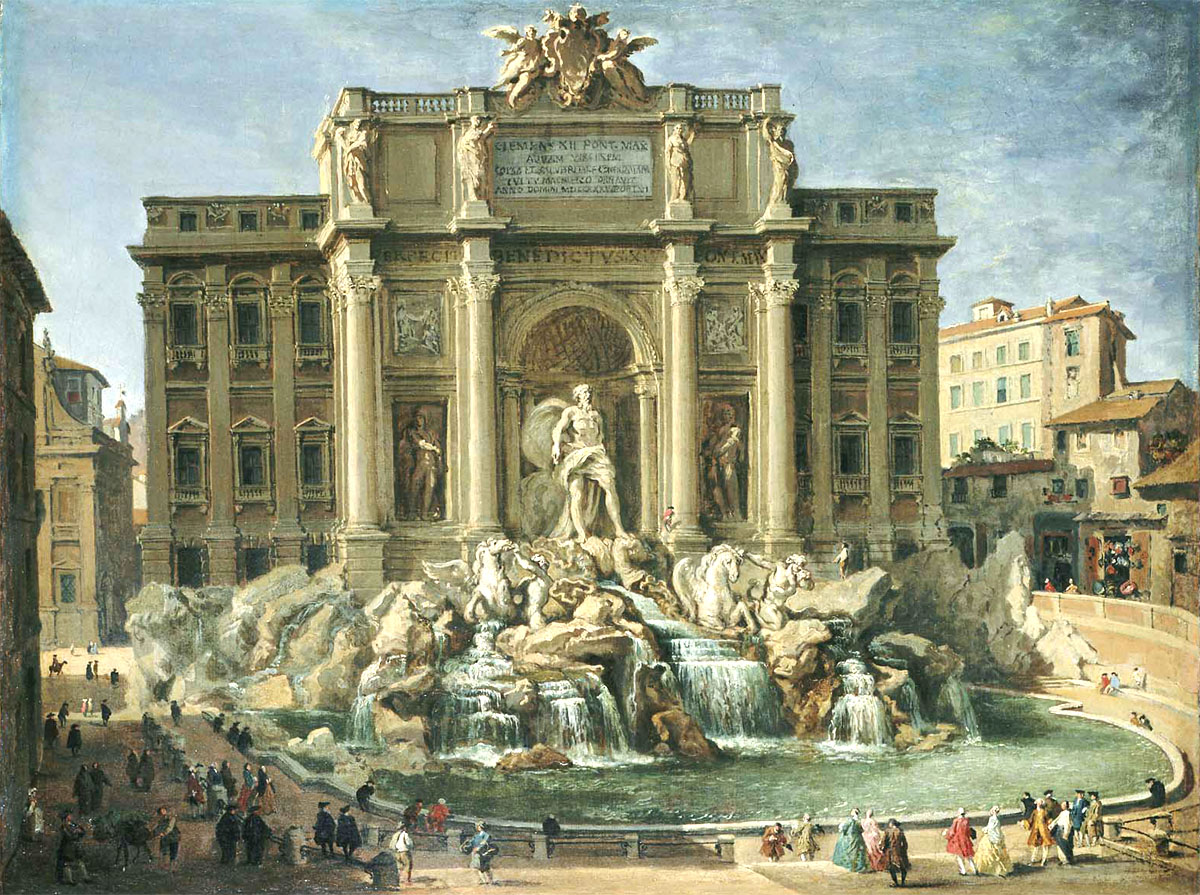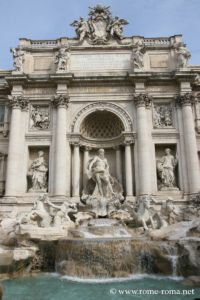The Trevi Fountain is undoubtedly the most famous fountain in Rome. A true Baroque masterpiece, it embodies the magic of the city and its majestic, accomplished art. Its worldwide fame is partly due to its place in the collective imagination since the iconic scene in La Dolce Vita by Fellini.
Traditions around the Fountain
In the main basin, symbolizing the sea, visitors traditionally throw a coin — a gesture believed to ensure their return to Rome.
Another, more romantic ritual surrounds the fountain: on its left side, the “lovers’ little fountain” is where, according to legend, couples who drink from this source will remain faithful to each other.
Structure and Sculptures of the Fountain
The fountain unfolds like a monumental triumphal arch, with a deep niche from which a sculpted cliff descends into the basin, adorned with plants and elements that create a striking aquatic spectacle.
At the center, the statue of Ocean dominates, driving a shell-shaped chariot pulled by two horses – one angry, the other calm – controlled by two tritons.
Reliefs decorate the fountain, illustrating the story of the aqueduct, while allegorical figures on the theme of water adorn the façade.
→ See also the full description of the Trevi Fountain
Brief History of the Fountain
The history of the Trevi Fountain spans several centuries and is closely interwoven with that of the city of Rome, dating back to the origins of the Roman Empire. It stands at the end of the Aqua Virgo Aqueduct (or *Aquedotto Vergine*, meaning Virgin Aqueduct in French), completed in 19 BCE, and still the only ancient aqueduct in operation today.
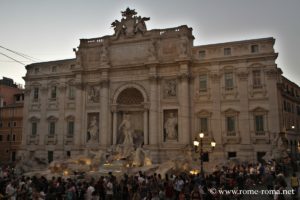 The fountain has been documented since the Middle Ages. Its name may either come from the nearby district, known as regio Trivii since the 12th century, or from the triple water outlet of the original fountain.
The fountain has been documented since the Middle Ages. Its name may either come from the nearby district, known as regio Trivii since the 12th century, or from the triple water outlet of the original fountain.
In 1640, Bernini designed a new version of the fountain. However, the monument we know today, designed by Nicola Salvi and Giuseppe Pannini, was built between 1732 and 1762, using materials such as travertine, marble, plaster, stucco, and metals.
After an initial restoration in 1989–1991, another renovation took place between 2014 and 2015.
| Tickets to visit the Trevi Fountain |
Photo Gallery
- Fontaine de Trevi
- Arc central
- Arco centrale
- Arc central
Map and address
Address : Piazza di Trevi, 00187 Roma RM, ItalieIf you see this after your page is loaded completely, leafletJS files are missing.
Information and Visits
| Fontana di Trevi Piazza di Trevi, 00187 Roma |
Sources and Links
|
Ancient views in art
Articles about the Trevi Fountain
Complete Description of the Trevi Fountain
 The fountain stands against the Palazzo Poli, which dates from 1728–1730. The level of the square was lowered due to the low elevation of the Acqua Vergine aqueduct.
The fountain stands against the Palazzo Poli, which dates from 1728–1730. The level of the square was lowered due to the low elevation of the Acqua Vergine aqueduct.
The theme of the entire composition is the sea.
A large rectangular basin with rounded corners is surrounded by a walkway, itself bordered by a short staircase that rises slightly to street level.
There is a marked difference in elevation between the left and right sides of the street.
The scene is dominated by a rocky cliff that occupies the entire lower part of the building. In the center, a large niche framed by columns and topped with a coffered ceiling houses a large statue of Ocean, who rides a shell-shaped chariot pulled by two winged horses, themselves guided by tritons.
Two smaller niches flank the central one. The right niche contains the statue of Salubrity, and the left one the statue of Prosperity, by Filippo della Valle, alluding to the benefits of pure water.
The three niches are framed by four large columns. The two horses are referred to as the “restless horse” (on the left), which is more dynamic than the other: the “calm horse”, representing the contrasting moods of the ocean, sometimes calm, sometimes turbulent.
The two panels above the smaller niches feature bas-reliefs depicting Agrippa approving the construction of the Aqua Virgo aqueduct (on the left, above Prosperity) and, on the right, the legend of the young girl showing soldiers the location of the spring.
The four large Corinthian columns support an attic, above which are four small allegorical statues, from left to right: the “abundance of fruit”, the “fertility of the fields”, the “wealth of autumn”, and the “layout of gardens”.
Between the two central statues stands the imposing coat of arms of Pope Clement XII, supported by two cherubs, above the large inaugural inscription:
CLEMENS XII PONT MAX
AQVAM virginem
COPIE ET SALVBRITATE COMMENDATAM
CVLTV MAGNIFIQUE ORNAVIT
Anno Domini MDCCXXXV pontife VI
The travertine cliff is also sculpted with animals and plants, amidst various water flows. These final decorative elements were created by several artists such as Maini, Pincellotti, Bracci, Della Valle, along with numerous craftsmen from various trades (goldsmiths, carpenters, painters, masons, sculptors…), all coordinated by Salvi.  Water emerges from several outlets to flow into the large basin, contributing to the unique and monumental character of this majestic fountain.
Water emerges from several outlets to flow into the large basin, contributing to the unique and monumental character of this majestic fountain.
Water notably flows out from beneath the chariot into three reservoirs before cascading into the main basin. These three reservoirs were not part of Salvi’s original design but were added by Giuseppe Pannini.
On the rocks covering the ramp on the left side of the fountain, a large travertine vase was sculpted, which has nothing to do with the fountain’s theme. Gossip from the time (which seems plausible) claims that Salvi had it made to block the view of a barber whose shop overlooked the fountain and who constantly criticized the architect’s work.

